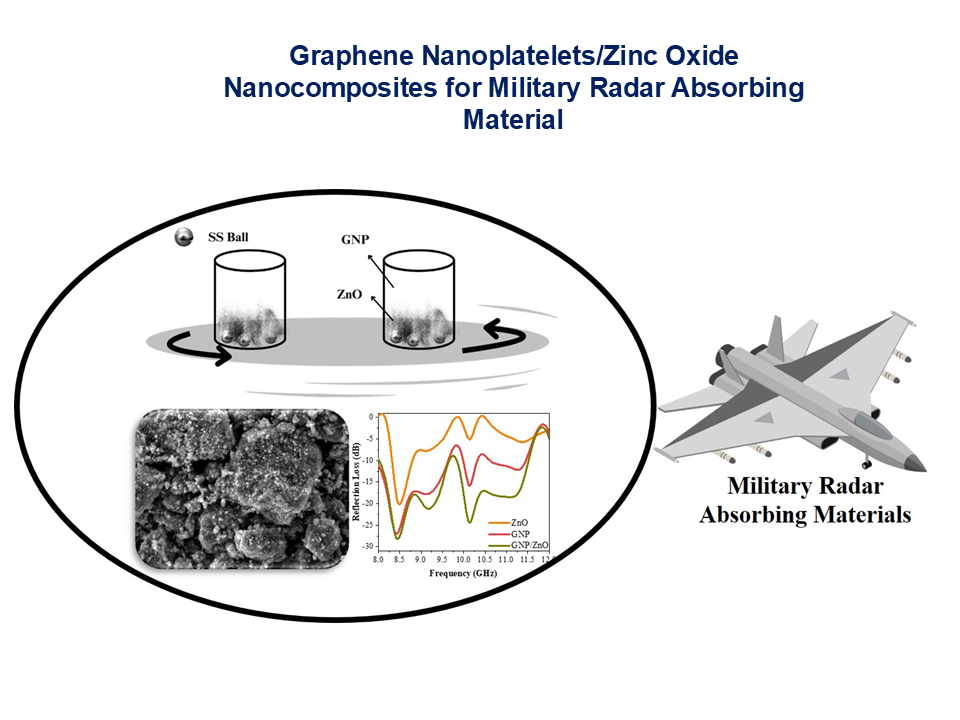Fabrication and Characterization of Graphene Nanoplatelets/Zinc Oxide Nanocomposites as a Military Radar Absorbing Material
DOI:
https://doi.org/10.55749/ijcs.v4i1.69Keywords:
Graphene Nanoplatelets, Nanocomposites, Planetary Ball Milling, Radar absorbing material, Zinc dioxideAbstract
Stealth aircraft have the capability to intercept radar waves. One common technique involves the use of radar-absorbing materials (RAMs). This study focused on the synthesis of advanced lightweight functional materials derived from advanced carbon and semiconductor compounds for microwave absorbing through mechanical homogenization. Graphene nanoplatelets (GNP) and Zinc Oxide (ZnO) possess excellent dielectric and magnetic loss capability due to their thermal conductivity, small particle size, large surface area, disordered structure, and lightweight nature. The GNP and ZnO were developed as advanced carbon and semiconductor nanocomposites using Planetary Ball Milling (PBM) at a ratio of 1:1. This approach aimed to improve the structure, morphology, and electromagnetic performance of the materials. A comparison between the nanocomposite materials and their precursors was conducted to clarify the advantages of using nanocomposites. FE-SEM showed the layered carbon sheets in GNP. XRD exhibited the alteration in the crystallite structure of ZnO, while FTIR spectroscopy confirmed the presence of specific functional groups. In addition, the GNP/ZnO nanocomposites showed strong microwave polarization capabilities. Notably, the GNP/ZnO nanocomposite achieved the lowest RL value compared to the precursor materials with a value of -28.21 dB at 8.45 GHz and a thickness of 3 mm in the scope of X-band range. While the through power was calculated at 99.84%. Through mechanical homogenization, a well-structured disordered crystallite layered material was fabricated for military RAMs. In the industrial sector, GNP/ZnO nanocomposites showed promising potential as a lightweight and advanced functional material for future stealth aircraft applications.
References
Atay, H.Y. & İçin, Ö. 2020. Manufacturing radar-absorbing composite materials by using magnetic Co-doped zinc oxide particles synthesized by Sol-Gel. J. Compos. Mater. 54. 4059–4066. doi: https://doi.org/10.1177/0021998320927754.
Wang, X., Zhao, C., Li, C., Liu, Y., Sun, S., Yu, Q., Yu, B., Cai, M. & Zhou, F., 2024. Progress in MXene-based materials for microwave absorption. J. Mater. Sci. Technol. 180. 207–225. doi: https://doi.org/10.1016/j.jmst.2023.08.064.
Ruiz-Perez, F., López-Estrada, S.M., Tolentino-Hernández, R.V. & Caballero-Briones, F., 2022. Carbon-based radar absorbing materials: A critical review. J. Sci.: Adv. Mater. Devices. 7(3). 100454. doi: https://doi.org/10.1016/j.jsamd.2022.100454.
Elmahaishi, M.F., Azis, R.A.S., Ismail, I. & Muhammad, F.D., 2022. A review on electromagnetic microwave absorption properties: their materials and performance. J. Mater. Res. Technol. 20. 2188-2220. doi: https://doi.org/10.1016/j.jmrt.2022.07.140.
Chitraningrum, N., Marlina, R., Arundina, R.Y., Suryani Togatorop, E.R., Sulistyaningsih, S., Arisesa, H., Budiman, I., Daud, P. & Hamzah, M., 2022. Microwave absorption properties of porous activated carbon-based palm oil empty fruit bunch. AIP Adv. 12(11). doi: https://doi.org/10.1063/5.0128960.
Panda, S.S.S., Gandi, S., Panigrahi, T. & Parne, S.R., 2023. Investigation of electromagnetic wave absorption properties of Ramphal leaves. J. Mater. Sci.: Mater. Electron. 34(15). 1207. doi: https://doi.org/10.1007/s10854-023-10610-8.
Elmahaishi, M.F., Azis, R.A.S., Ismail, I. & Muhammad, F.D., 2022. A review on electromagnetic microwave absorption properties: their materials and performance. J. Mater. Res. Technol. 20. 2188-2220. doi: https://doi.org/10.1016/j.jmrt.2022.07.140.
Wang, D.C., Lei, Y., Jiao, W., Liu, Y.F., Mu, C.H. & Jian, X., 2021. A review of helical carbon materials structure, synthesis and applications. Rare Metals. 40. 3-19. doi: https://doi.org/10.1007/s12598-020-01622-y.
Zhang, Y., Heo, Y.J., Son, Y.R., In, I., An, K.H., Kim, B.J. & Park, S.J., 2019. Recent advanced thermal interfacial materials: a review of conducting mechanisms and parameters of carbon materials. Carbon. 142. 445-460. doi: https://doi.org/10.1016/j.carbon.2018.10.077.
Gorokhov, G., Bychanok, D., Meisak, D., Shlyk, I., Liubimau, A., Angelova, P., Menseidov, C., Ivanov, E., Kotsilkova, R., Casa, M. & Ciambelli, P., 2019, March. Carbon nanotubes vs graphene nanoplatelets for 3D-printable composites. IOP Conf. Ser. Mater. Sci. Eng. 503(1). 012010. doi: https://doi.org/10.1088/1757-899X/503/1/012010.
Yee, K. & Ghayesh, M.H., 2023. A review on the mechanics of graphene nanoplatelets reinforced structures. Int. J. Eng. Sci. 186. 103831. doi: https://doi.org/10.1016/j.ijengsci.2023.103831.
Jang, B.Z. & Zhamu, A., 2008. Processing of nanographene platelets (NGPs) and NGP nanocomposites: a review. J. Mater. Sci. 43(15). 5092-5101. doi: https://doi.org/10.1007/s10853-008-2755-2.
Cataldi, P., Athanassiou, A. & Bayer, I.S., 2018. Graphene nanoplatelets-based advanced materials and recent progress in sustainable applications. Appl. Sci. 8(9). 1438. doi: https://doi.org/10.3390/app8091438.
Liang, Y., Yuan, Y., Wang, B., Wang, Y. & Wei, S., 2021. Microstructure and microwave absorption properties of ZnO with different surfactants by hydrothermal method. J. Mater. Sci.: Mater. Electron. 32(21). 25908-25918. doi: https://doi.org/10.1007/s10854-020-05226-1.
Cai, M., Shui, A., Wang, X., He, C., Qian, J. & Du, B., 2020. A facile fabrication and high-performance electromagnetic microwave absorption of ZnO nanoparticles. J. Alloys Compd. 842. 155638. doi: https://doi.org/10.1016/j.jallcom.2020.155638.
Paul, N., Jimmy, J., Chakyar, S.P., Simon, S.K., Kizhakooden, J., Bindu, C., Sebastian, A., Umadevi, K.S., Jose, J., Andrews, J. & Joseph, V.P., 2019. Microwave absorption properties of flexible zinc oxide sheet. In AIP Conf. Proc. 2162(1). 020070. doi: https://doi.org/10.1063/1.5130280.
Pohshna, C. & Mailapalli, D.R., 2023. Modeling the particle size of nanomaterials synthesized in a planetary ball mill. OpenNano. 14. 100191. doi: https://doi.org/10.1016/j.onano.2023.100191.
Piras, C.C., Fernández-Prieto, S. & De Borggraeve, W.M., 2019. Ball milling: a green technology for the preparation and functionalisation of nanocellulose derivatives. Nanoscale Adv. 1(3). 937–947. doi: https://doi.org/10.1039/C8NA00238J.
Chen, Q., Liu, X., Wang, T., Su, X., Liu, M., Chaemchuen, S. & Verpoort, F., 2023. A solvent-free process enabling ZnO/porous carbon with enhanced microwave absorption. J Mater. Sci. Technol. 149. 255–264. doi: https://doi.org/10.1016/j.jmst.2022.12.034.
Kholil, M.A., Priyono, P. & Subagio, A., 2022. Multiwalled carbon nanotubes and zinc oxide using a high energy milling method for radar-absorbent. Mater. Res. Express. 9(2). 025003. doi: https://doi.org/10.1088/2053-1591/ac4e3a.
Zhang, W., Zheng, Y., Zhang, X., Zhu, Q., Tian, L., Wu, H., Yan, H. & Qi, S., 2019. Structure-microwave absorption performance correlations of GNPs/ZnO nanocomposite absorber: Synthesis, characteration and mechanism investigation. Ceram. Int. 45(10). 13376-13384.. doi: https://doi.org/10.1016/j.ceramint.2019.04.033.
Fahri, M., Bolilanga, P.I.W., Gunaryo, G., Stiawan, E. and Kurniadi, T., 2024. Exploring the potential of carbon-based radar absorbing material innovations. Indones. J. Chem. Stud. 3(2). 72-81. doi: https://doi.org/10.55749/ijcs.v3i2.56.
Negi, P. & Kumar, A., 2022. Biomass-derived activated carbon/epoxy composite as microwave absorbing material. J. Electron Mater. 51(6). 2918-2925. doi: https://doi.org/10.1007/s11664-022-09558-y.
Zheng, H., Zhang, W., Li, B., Zhu, J., Wang, C., Song, G., Wu, G., Yang, X., Huang, Y. & Ma, L., 2022. Recent advances of interphases in carbon fiber-reinforced polymer composites: A review. Compos. B. Eng. 233. 109639. doi: https://doi.org/10.1016/j.compositesb.2022.109639.
Setua, D.K., Mordina, B., Srivastava, A.K., Roy, D. & Prasad, N.E., 2020. Carbon nanofibers-reinforced polymer nanocomposites as efficient microwave absorber. In Fiber-reinforced nanocomposites: fundamentals and applications. 395-430. Elsevier. doi: https://doi.org/10.1016/B978-0-12-819904-6.00018-9.
Ahmad, I., Nazeri, M.F.M., Salleh, N.A., Kheawhom, S., Erer, A.M., Kurt, A. & Mohamad, A.A., 2021. Selective electrochemical etching of the Sn-3Ag-0.5 Cu/0.07 wt% graphene nanoparticle composite solder. Arab. J. Chem. 14(10). 103392. doi: https://doi.org/10.1016/j.arabjc.2021.103392.
Klug, H.P. & Alexander, L.E., 1974. X-ray diffraction procedures: for polycrystalline and amorphous materials. ISBN 0-471-49369-4. Wiley-VCH.
Scherrer, P., 1918. Bestimmung der Grosse und inneren Struktur von Kolloidteilchen mittels Rontgenstrahlen. Nach Ges Wiss Gottingen. 2. 8-100.
Terinte, N., Ibbett, R. and Schuster, K.C., 2011. Overview on native cellulose and microcrystalline cellulose I structure studied by X-ray diffraction (WAXD): Comparison between measurement techniques. Lenzinger Berichte. 89(1). 118-131.
Uzun, İ., 2023. Methods of determining the degree of crystallinity of polymers with X-ray diffraction: a review. J. Polym. Res. 30(10). 394. doi: https://doi.org/10.1007/s10965-023-03744-0.
Rajith Kumar, C.R., Betageri, V.S., Nagaraju, G., Pujar, G.H., Onkarappa, H.S. & Latha, M.S., 2020. Synthesis of core/shell (ZnO/Ag) nanoparticles using Calotropis gigantea and their applications in photocatalytic and antibacterial studies. J. Inorg. Organomet. Polym. Mater. 30(9). 3410-3417. doi: https://doi.org/10.1007/s10904-020-01507-8.
Jarvin, M., Kumar, S.A., Rosaline, D.R., Foletto, E.L., Dotto, G.L. & Inbanathan, S.S.R., 2022. Remarkable sunlight-driven photocatalytic performance of Ag-doped ZnO nanoparticles prepared by green synthesis for degradation of emerging pollutants in water. Environ. Sci. Pollut. Res. 29(38). 57330-57344. doi: https://doi.org/10.1007/s11356-022-19796-6.
Wang, Q., Wang, Y., Meng, Q., Wang, T., Guo, W., Wu, G. & You, L., 2017. Preparation of high antistatic HDPE/polyaniline encapsulated graphene nanoplatelet composites by solution blending. RSC Adv. 7(5). 2796-2803. doi: https://doi.org/10.1039/C6RA26458A.
Mahalakshmi, S., Hema, N., Vijaya, P.P. 2020. In vitro biocompatibility and antimicrobial activities of zinc oxide nanoparticles (ZnO NPs) prepared by chemical and green synthetic route—a comparative study. BioNanoScience. 10(1). 112-121. doi: https://doi.org/10.1007/s12668-019-00698-w.
Marki microwave. 2016. Return Loss to VSWR Conversion Table. 100. 95037.
Sun, X., Wang, Y., Kimura, H., Ni, C., Hou, C., Wang, B., Zhang, Y., Yang, X., Yu, R., Du, W. & Xie, X., 2023. Thermal stability of Ni3ZnC0. 7: As tunable additive for biomass-derived carbon sheet composites with efficient microwave absorption. J. Colloid Interface Sci. 642. 447-461. doi: https://doi.org/10.1016/j.jcis.2023.03.194.

Downloads
Published
How to Cite
Issue
Section
License
Copyright (c) 2025 Indonesian Journal of Chemical Studies

This work is licensed under a Creative Commons Attribution-ShareAlike 4.0 International License.

















